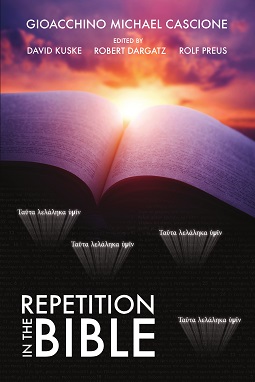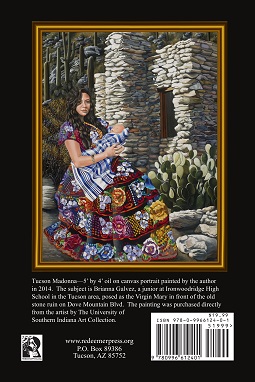
Front Cover

Back Cover
|
Repetition in the Bible
By Gioacchino Michael Cascione
Edited by David Kuske • Robert Dargatz • Rolf Preus
- Examines repetition in both the Old and New Testaments
- Explores the form, origin, and purpose of repetition in the Bible
- Evidence for the authenticity of Scripture
- Evaluates the text as an ancient artifact
- Quotes more than 5,000 verses as evidence of repetition in the Bible
- Translates all repetition from the Greek and Hebrew for the lay reader
- Written for students of the Bible
- Softcover (6 x 9 inch): 424 pages
The First Book to Record Repetition in the Bible
Since the time of publication of the Bible after 325 A.D.,
this is the first book to research, record, and compare repetition in the Old
and New Testaments as found in the original Greek and Hebrew.
There Is Nothing New in this Book
“There is nothing new under the sun” (Ecclesiastes 9:1).
There are things misunderstood, forgotten, hidden, and unknown, but not new.
There is nothing new in this book that was not written 3,500 years ago, but
there is always more to be learned from the Bible.
Repetition Is Unique to the Bible
The permeation of repetition in every book of the Old and
New Testaments establishes a literary genre and unity unique to the Bible. The
presence of repetition also confirms the uncompromised authenticity and
authority of the Bible’s text. The text we read is the text the prophets and apostles
wrote.
Monuments versus Scrolls
The mystery of the Great Pyramid’s construction continues to draw the attention of scholars, documentarians,
authors, and archeologists. Yet, the mysteries of the pyramids pale by
comparison to the mysteries of how repetition was written into the Bible. The
Egyptians built stone monuments to achieve immortality, while their slaves
pursued the same goal through the word of God they recorded on sacred scrolls.
Immediately after crossing the Red Sea, Moses writes, Until Thy people pass
over, O LORD, Until the people pass over whom Thou hast purchased. Thou
wilt bring them and plant them in the mountain of Thine inheritance, The place,
O LORD, which Thou hast made for Thy dwelling, The sanctuary, O Lord, which Thy
hands have established (Exodus 15:16b-17 NASB).
Repetition in the Gospels
The first 4 chapters of this book record repetition in
Matthew, Mark, Luke, and John. Repetition in the Gospels follows the same
repetition found in Genesis. At times, identical repetition is found in 2 or
more of the Gospels. In other instances, all 4 Gospels repeat the same
phrasing from Genesis.
Repetition: An Aid to Identify the Original Text
With 5,800 complete or fragmented Greek manuscripts,
there is much debate among scholars about the original text. Word by word and
phrase by phrase repetition in the Bible is an important tool in selecting the
correct variant reading recorded in the original autographs.
Repetition Addresses a Wide Range of Subjects
A study of repetition in the Bible led to an examination of
genealogy, chronology, the history of ancient mathematics, Babel, the
antediluvian and postdiluvian patriarchs, the Babylonian legacy of recording
time, the tȏledȏth [generations] formulas,
the Tabernacle, variant readings in ancient Greek manuscripts, chiasm, the
taxonomy of repetition, asymmetric versus symmetric order, the Documentary Hypothesis,
ancient manuscript authentication, the Gnostic Gospels, the so-called lost
Gospel (sayings of Jesus) of Q, the “theorized” Markan Priority, and the alleged
influence of the Septuagint and the Vulgate on the Masoretic Text.
Repetition Is About Emphasis, Not Doctrine
Repetition in the Bible does not reveal new doctrine; but there
are some unexpected areas of emphasis. For example, while Jesus Christ is the
focal point of all 4 Gospels, prominent names and subjects, such as God the
Father, John the Baptist, Peter, David, faith, heaven, Mary the mother of Jesus, John 6, foot washing, the
final discourse, and others, are given unique emphasis with repetition.
3 Important Authors on Repetition
After publishing the 1987 and 2012 editions of In Search
of the Biblical Order, the work of identifying, naming, and understanding
repetition in the Bible was built upon the research of 3 scholars.
Rabbi Eyal Rav-Noy published chiasm and metered words from
Moses in his book Who Really Wrote the Bible? He advised this writer to
study the works of Umberto Cassuto.
Hebraic scholar Umberto Cassuto’s 3 commentaries demonstrate
individual metered words in Genesis and Exodus, while his series of 8 lectures
published as The Documentary Hypothesis defends Mosaic authorship of the
Pentateuch. He was the chief Rabbi of Florence until he was hired by the
Vatican in 1925 as the archivist of Semitic scrolls. He fled to Jerusalem in
1938.
Doctor Diana Jill Kirby’s dissertation, presented at
American University in Washington, DC, was the first to publish the taxonomy of
repetition in Revelation.
These 3 key writers, when combined with this author’s 1987
and 2012 editions, supplied the primary direction for Repetition in the
Bible. Additional insights were gathered from books by John Breck, E. W.
Bullinger, David Dorsey, James B. Jordan, and Meir Sternberg.
Errata for Print Copy Corrected in E-book Edition
March 15, 2016
| p. 21, line 4 |
Remove asterisk following << Gospel of Matthew* >> |
| p. 21, line 8 |
Add asterisk to end of line << (Matt.
15:5 BNT)*
>> |
| p. 21, line 12 |
Replace <<
15:6 >>
with << 15:5 >> |
| p. 85, line 25 |
Replace << 100
repetitions in all 4 Gospels?” >> with << 100 repetitions of amen in all 4 Gospels?” >> |
| p. 103, line 29 |
Replace << He said to him, 20 >> with <<
He said to him, 20 >> |
| p. 111, line 30 |
Replace <<
τι >> with << ὅτι >> |
| p. 174, lines 37-41 |
Replace
<< Nation: 24, ἔθνος
(ethnos, eth’-nos) 2:26; 5:9; 7:9; 10:11; 11:2, 9, 18;
12:5; 13:7; 14:6, 8; 15:3, 4; 16:19; 17:15; 18:3, 23; 19:15; 20:3, 8; 21:24
(x2), 26; 22:2; BNT, BYZ, GNT, GOC, TIS at 15:3 have nation, while
SCR, STE, WHO have saints; BYZ adds of the nations at 21:24; GOC
variant rejected, which has nation rather than dead at 11:18; >>
with
<< Nation: 24, ἔθνος (ethnos,eth’-nos) 2:26; 5:9; 7:9; 10:11; 11:2, 9, 18
(x2); 12:5; 13:7; 14:6, 8; 15:3, 4; 16:19; 17:15; 18:3, 23; 19:15; 20:3, 8;
21:24, 26; 22:2; BNT, BYZ, GNT, GOC, TIS at 15:3 have nation, while
SCR, STE, WHO have saints; BYZ adds of the nations at 21:24; variant
rejected; GOC has nation not dead at 11:18; variant accepted;
>> |
| p. 224, line 13 |
Replace <<
linier >> with << linear >> |
| p. 251, line 28 |
Remove <<
see also list of decads; >> (It
should have been “see also list of dodecads;”, which are not listed.) |
| p. 307, line 43 |
Replace <<
Numbers >> with << Leviticus >> |
The Editors
Reviews
Chapter Outline
Preface
Order Now
|

